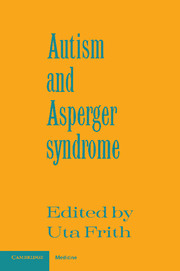Book contents
- Frontmatter
- Contents
- List of illustrations
- Acknowledgements
- 1 Asperger and his syndrome
- 2 ‘Autistic psychopathy’ in childhood
- 3 The relationship between Asperger's syndrome and Kanner's autism
- 4 Clinical and neurobiological aspects of Asperger syndrome in six family studies
- 5 Asperger syndrome in adulthood
- 6 Living with Asperger's syndrome
- 7 The autobiographical writings of three Asperger syndrome adults: problems of interpretation and implications for theory
- Name Index
- Subject Index
2 - ‘Autistic psychopathy’ in childhood
Published online by Cambridge University Press: 18 December 2009
- Frontmatter
- Contents
- List of illustrations
- Acknowledgements
- 1 Asperger and his syndrome
- 2 ‘Autistic psychopathy’ in childhood
- 3 The relationship between Asperger's syndrome and Kanner's autism
- 4 Clinical and neurobiological aspects of Asperger syndrome in six family studies
- 5 Asperger syndrome in adulthood
- 6 Living with Asperger's syndrome
- 7 The autobiographical writings of three Asperger syndrome adults: problems of interpretation and implications for theory
- Name Index
- Subject Index
Summary
In what follows, I will describe a particularly interesting and highly recognisable type of child. The children I will present all have in common a fundamental disturbance which manifests itself in their physical appearance, expressive functions and, indeed, their whole behaviour. This disturbance results in severe and characteristic difficulties of social integration. In many cases the social problems are so profound that they overshadow everything else. In some cases, however, the problems are compensated by a high level of original thought and experience. This can often lead to exceptional achievements in later life. With the type of personality disorder presented here we can demonstrate the truth of the claim that exceptional human beings must be given exceptional educational treatment, treatment which takes account of their special difficulties. Further, we can show that despite abnormality human beings can fulfil their social role within the community, especially if they find understanding, love and guidance. There are many reasons for describing in detail this type of abnormally developing child. Not the least of them is that these children raise questions of central importance to psychology and education.
Name and Concept
I have chosen the label autism in an effort to define the basic disorder that generates the abnormal personality structure of the children we are concerned with here. The name derives from the concept of autism in schizophrenia. Autism in this sense refers to a fundamental disturbance of contact that is manifest in an extreme form in schizophrenic patients.
- Type
- Chapter
- Information
- Autism and Asperger Syndrome , pp. 37 - 92Publisher: Cambridge University PressPrint publication year: 1991
- 301
- Cited by

